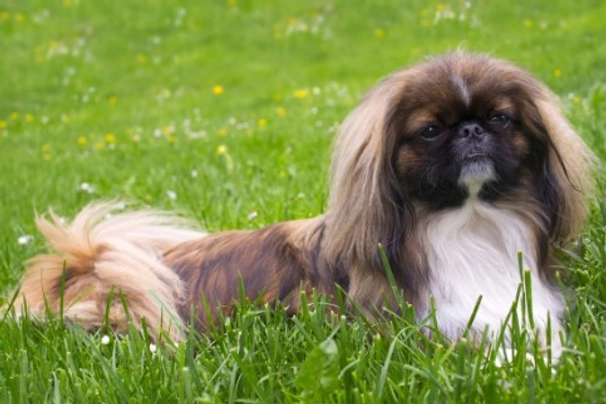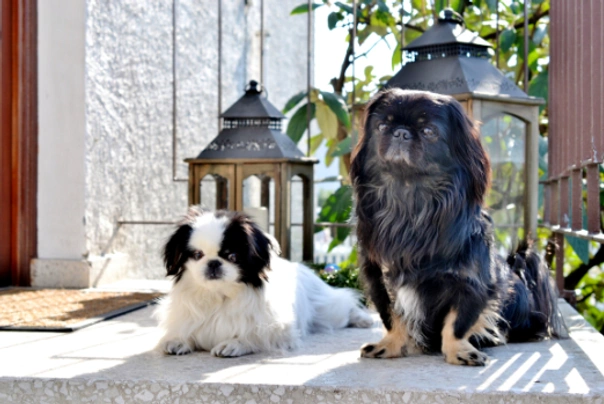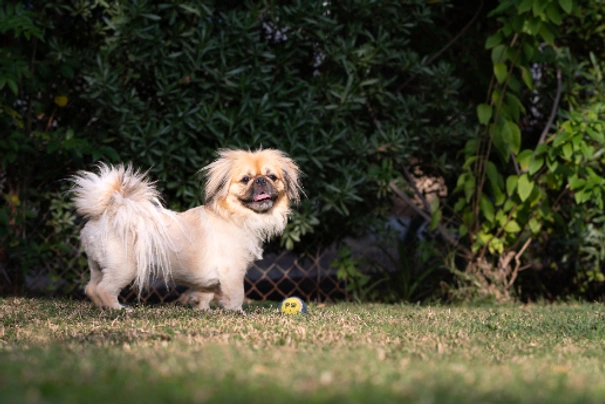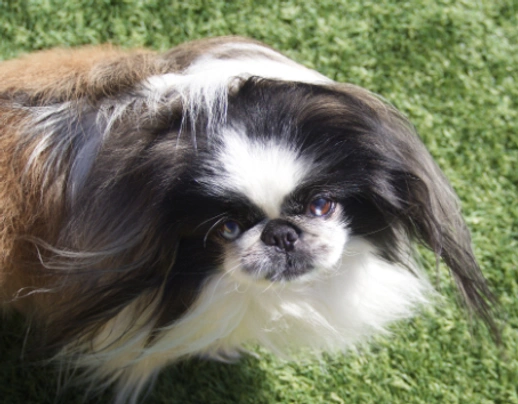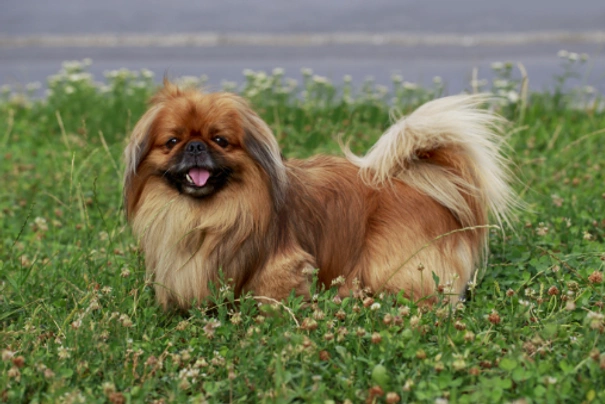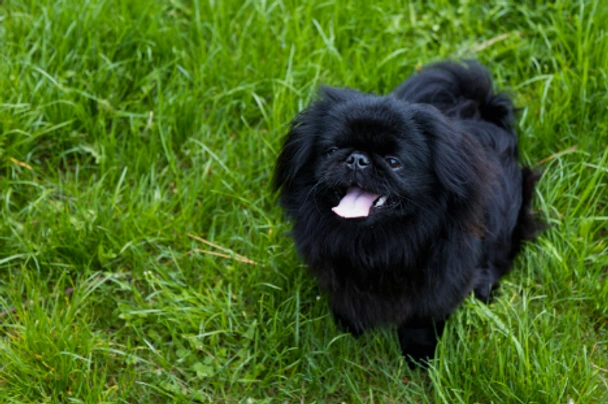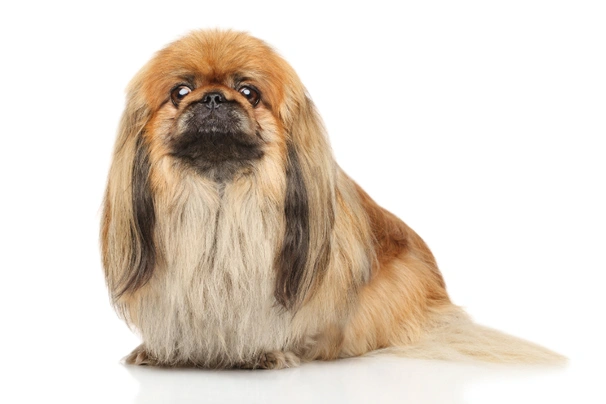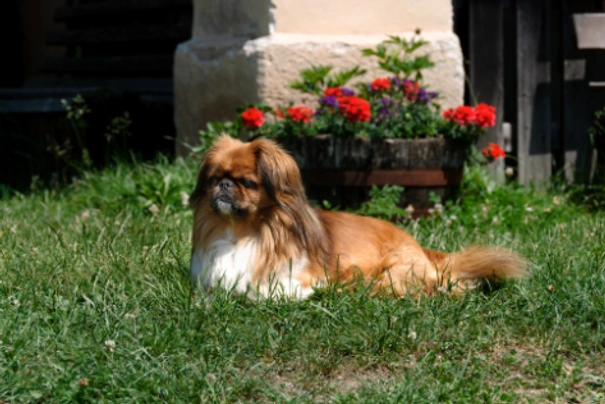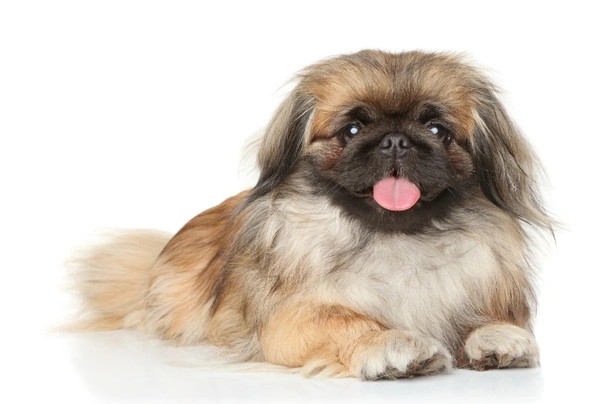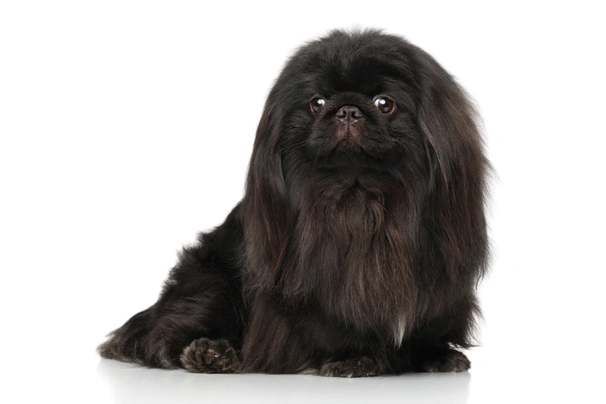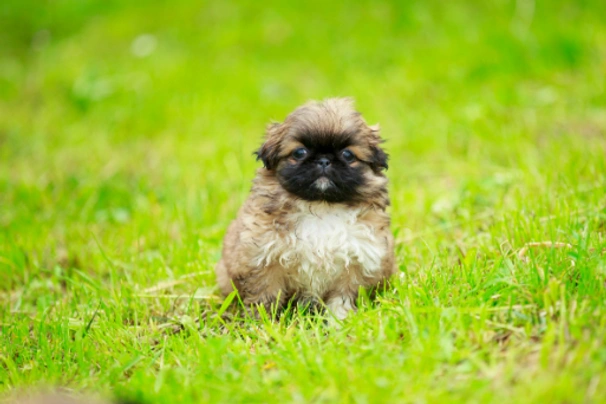Pekingese
Pros
Cons
Introduction of the Pekingese
The Pekingese is a charming little dog and one that boasts a fascinating history. Over the years they have become a popular choice both here in the UK not only because of their adorable looks but also for their kind loyal and affectionate natures. The Pekingese of today is very much the same as the dogs of days long past and they have found their way into the hearts and homes of many people the world over.
Pekes are known for being wonderful companions for elderly people because they are not overly demanding when it comes to daily exercise. With this said the Pekingese is not a couch potato either with many of these small dogs thoroughly enjoy and doing well at all sorts of canine sports which includes mini agility.
History of the Pekingese
Although the true origins of the Pekingese have been lost in the sands of time it is likely that these little dogs have not altered that much over centuries. Chinese legend tells of a lion that fell in love with a marmoset and to marry to her the lion begged the patron saint of the animals Ah Chu to reduce him to the size of a pigmy while at the same time retaining his large lion heart and character. The offspring of this union was the Fu Lin or Lion Dog of China which paved the way for the Pekingese to make its mark on the whole of China. Whatever the breed’s true origin recent DNA tests have revealed the Peke to be one of the most ancient of all dog breeds along with 13 others.
The charming Pekingese's ancestry is an illustrious one that can be traced back to China's Tang Dynasty with similar little dogs having been popular in China even before that particular time in Chinese history. However it was during the Tang Dynasty that these little lion dogs became a firm favourite around the Imperial Courts. They were so highly prized that a decree was passed stating that only royals and nobles could own a Pekingese and that no commoners were allowed to purchase or own a Pekingese dog and if they did it was at their own peril.
It was only in 1860 that common people could buy one of these charming little lion-like dogs which was when the British took over the city of Peking and when they ransacked the Summer Palace. They found 5 Pekingese which Lord John Hay Sir George Fitzroy and General Dunne took back to England with them. The General presented his Pekingese called "Looty" to Queen Victoria who kept her pet until 1872 when Looty died.
The 2 Pekes that Lord Hay bought back to England with him were called Hytien and Schloff. The Lord gave Hytien the female Peke to his sister the Duchess of Wellington who began breeding from her using Schloff. Sir Fitzroy gave the 2 Pekes he bought back with him from his tour of duty in China to his cousin The Duchess of Richmond and Gordon. They were called Guh and Meh and the Duchess began a breeding programme which was to become the now famous Goodwood line.
In 1910 The Kennel Club recognised the breed although the Pekingese was accepted by the American Kennel Club the previous year. Today the Pekingese remains one of the most popular choices both as a companion dog and family pet thanks to their charming looks endearing natures and the fact they are so loyal without being overly demanding.
Interesting facts about the breed
- Is the Pekingese a vulnerable breed? No they are among some of the more popular breeds in the UK being ranked 84 out of 238 other breeds (As at February 2018) on the Pets4homes website
- The Pekingese is thought to be one of the more ancient breeds in the world
- At one time during China's history no common person could own a Pekingese
- They were often called "sleeve dogs" because they were bred to be small and therefore easier to carry
- A Pekingese along with 2 Pomeranians escaped off the Titanic when it sank
Appearance of the Pekingese
Height at the withers: Males 15 - 23 cm Females 15 - 23 cm
Average weight: Males 3.5 - 6.5 kg Females 3.5 - 6.5 kg
The Pekingese boasts having very lion-like looks with long silky hair that reaches the ground and lovely manes around their necks. They have very distinct wrinkled flat faces which although adorable often causes breathing and eye problems for the breed. A Peke's head is large in relation to their body and it's wider than it is deep with dogs having moderately broad skulls that are flat in between their ears. They have a nicely defined stop and although flat faced their muzzles should be relatively wide while at the same time not being too short. Their noses are short and have broad wide open nostrils. They have some wrinkling on their faces that goes from their cheeks to the bridge of the nose which forms an inverted "V". The pigment on their nose eye rims and lips is always black in colour which accentuates nicely a dog’s expressive eyes.
Their eyes are round clear and have a lovely dark lustre in them. Their ears are heart shaped and set level with a dog's skull which they carry close to their heads. Their ears boast having a profuse amount of feathering that adds to a Peke's charming appeal. Their lips are level with dogs having a firm under-jaw. Necks are quite thick and relatively short their front legs are heavily boned and thick which are often slightly bowed. Their shoulders are well laid-back blending nicely into a dog's body.
The Pekingese has quite a short body and a very distinct waist. Their chests are broad and ribs are well sprung with a nice level topline. Back legs are well muscled and strong although slightly lighter than their front legs. A Peke's feet are quite flat and large with their front feet often turning out slightly whereas their back feet point straight to the front. Their tails are set high which dogs carry slightly curved over their backs or sometimes a Peke will carry their tail to one side. Tails are nicely feathered.
When it comes to their coat the Pekingese has a moderately long straight hair with a very distinct mane around their necks that does not go any further back than a dog's shoulders. Their top coat is quite thick and coarse whereas the undercoat is that much softer. Dogs have lots of feathering on their ears on the back of their legs tails and toes. The accepted breed colours for Kennel Club registration are as follows:
- Black
- Black & Tan
- Black & White
- Brindle Black Mask
- Cream
- Cream Black Mask
- Fawn
- Fawn & Black
- Fawn Black Mask
- Fawn Brindle
- Fawn Brindle Black Mask
- Grey Brindle
- Light Red
- Particolour
- Red
- Red Black Mask
- Red Brindle
- Red Brindle Black Mask
- Red Fawn
- Red Fawn Black Mask
- Silver
- Silver Brindle
- Silver Fawn
- Silver Fawn Black Mask
- White
Gait/movement
When a Pekingese moves they do so in an extremely dignified way showing a typical "rolling" gait in their front quarters. Their coats should never hinder a dog's movement which is a serious fault.
Faults
The Kennel Club frowns on any exaggerations or departures from the breed standard and would judge the faults on how much they affect a dog's overall health and wellbeing as well as their ability to perform.
Males should have both testicles fully descended into their scrotums and it is worth noting that a dog can be a little lighter or heavier as well as slightly taller or shorter than set out in the Kennel Club breed standard which is given as a guideline only.
Temperament of the Pekingese
The Pekingese is known to have a real sense of humour but with this comes a whole lot of dignity. They are playful mischievous and yet quite sensitive little dogs by nature. They are a large dog in a small dog's body when it comes to personality. They can be a little protective of their toys which is a natural "guarding" trait that's deeply embedded in a Peke's psyche.
They love human company and thrive in an environment where one person usually stays at home when everyone else is out of the house so they don't have to spend too much time on their own. If not given enough exercise or having someone around for long periods of time a Peke can quickly develop separation anxiety and this can lead to a dog becoming depressed and destructive around the home. Pekes tend to form extremely strong bonds with one person in a household although they always show a lot of affection towards everyone else too.
They are known to be extremely social little dogs although they can be a little wary around strangers. However a Peke would just bark and keep their distance until they get to know someone rarely would one of these little dogs show any sort of aggressive behaviour towards a person they first meet unless they felt threatened in any way.
Because they are quite independent dogs they need to know their place in the pack and who they can look to for guidance and direction. It's important for these dogs to know what is expected of them which means their socialisation and training must start early and it should involve introducing a Peke to as many new situations people animals and other dogs once they have been fully vaccinated. When Pekes get away with too much they can start displaying "small dog syndrome" which sees dogs becoming a lot more demanding and harder to live with. Dogs get very possessive over their toys food and it's when separation anxiety can become a real issue which is why it's important not to "spoil" a Peke and let them get away with things a larger dog would never be allowed to do.
The Pekingese makes an ideal companion for the older person and prefers to be in a household where there is just one adult rather than in a home where there are lots of young children. Having said this in the right environment the Pekingese is a good choice for first time owners although anyone wishing to share their home with one of these charming little dogs would need to be willing to dedicate a lot of time to keeping their coats in good condition because they are high maintenance in the grooming department.
Are they a good choice for first time owners?
Pekes are the perfect choice for first time dog owners because they are so amenable and people-oriented loving nothing more than to please and to entertain their owners. With this said they are not a good choice for families with very young children because Pekes need to be handled with care and respected or they might get a bit snappy.
What about prey drive?
Pekes are very social by nature and as such they do not have a very high prey drive. However this is not to say that a dog would not give chase to a smaller animal when the mood takes them and this includes squirrels and the cat from next door whenever they get the chance.
What about playfulness?
Pekes have a very playful side to their natures and love to entertain and be entertained. They thoroughly enjoy playing interactive games with some Pekes excelling at all sorts of canine sports which includes mini agility.
What about adaptability?
Pekes are highly adaptable dogs providing they are given enough daily physical exercise combined with as much mental stimulation to prevent boredom from setting in they are just as happy living in an apartment in town as they are living in a house in the country.
What about separation anxiety?
Pekes form strong ties with their families and dogs are never very happy when they find themselves left on their own for longer periods of time. They are better suited to people who either work from home or in households where one person stays at home when everyone else is out so they are never alone for any length of time which could see a dog suffering from separation anxiety. This can lead to them being destructive around the home which is a dog's way of relieving any stress they are feeling and a way to keep themselves entertained.
What about excessive barking?
Some Pekes like the sound of their own voices a little too much which is something that needs to be gently nipped in the bud when a dog is still young being careful not to frighten them. Others will only bark when there are strangers about or when something they don't like is going on in their surroundings.
Do Pekingese like water?
Some Pekes like swimming and will take to the water whenever they can more especially when the weather is hot. However because they have such long dense coats and short muzzles care should always be taken when a Peke decides to go in the water because their heavy coats would drag them down and they could have trouble breathing being a brachycephalic breed.
Are Pekingese good watchdogs?
Pekes are not natural watchdogs although this is not to say a dog would not be quick off the mark to let an owner know when there are strangers about although they would rarely do this aggressively preferring to keep their distance and bark to alert their owners about a situation they find disturbing.
Intelligence / Trainability of the Pekingese
Pekes are known to be intelligent little dogs and they do like to please. However they boast a bit of a stubborn streak in them and are quite independent characters by nature which often means training them can prove a little challenging to say the least. The key to successfully training a Pekingese is not to rush things because these little dogs tend to do things in their "own time". In short it takes a lot of patience and understanding to successfully train a Peke.
Their training must start early it should be consistent and always fair so that a Peke understands what their owner expects of them. Socialising a dog early enough pays dividends because it helps these little dogs grow up to be more relaxed mature dogs that are a pleasure to have around and take anywhere. When they have not been well socialised a Pekingese can be a bit of a handful even though they are such small dogs.
Peke puppies are incredibly cute and it is all too easy to let them get away with things that an adult dog would never be allowed to do. However owners need to start out as they mean to go on which means setting out rules and boundaries of what is acceptable behaviour and what is not. All puppies need to know their place in the pack and what an owner expects of them like this they grow up to be well rounded adult dogs. A spoiled puppy may start to develop "small dog syndrome" which sees them being unruly and wilful making them harder to handle and live with. The first commands a puppy should be taught are as follows:
- Come
- Sit
- Stay
- Quiet
- Leave it
- Down
- Bed
Children and other
Pekes tend to thrive in a quieter home environment where the children are older because they can be snappy around smaller kids which can often be put down to the fact toddlers just don’t understand how to behave around dogs and as a result it makes a Peke nervous. As such they are not the best choice for families with young children.
They are not generally aggressive dogs by nature and will rarely pick a fight with another dog but if they feel threatened in any way a Peke would not think twice about standing their ground. They are much more relaxed around other dogs when they have been socialised from a young enough age and they do usually get on well with a family cat they have grown up with but would happily chase off a neighbour's cat whenever they get the chance. Care should be taken when a Peke is around smaller animals and pets just in case.
Health of the Pekingese
The average life expectancy of a Pekingese is between 11 and 13 years when properly cared for and fed an appropriate good quality diet to suit their ages.
Like so many other breeds the Peke is known to suffer from a few hereditary health issues which are worth knowing about if you are planning share your home with one of these energetic little dogs. The conditions that seem to affect the breed the most include the following:
- Hereditary and congenital deafness - BAER test available through the Animal Health Trust (AHT)
- Back problems more especially Intervertebral Disc Disease (IVVD)
- Eye issues and disorders
- Heart problems - breed clubs regularly hold heart testing days
- Breathing issues more especially due to stenotic nares and pinched nostrils
- Pyometra - a womb infection
- Dystocia - difficulty whelping with many Peke puppies having to be delivered by Caesarean Section
More about brachycephalic breeds and the shape of their heads and health issues
The Pekingese is a brachycephalic breed which describes the shape of their faces and heads. A Peke has a flat face very short muzzle and wide head although some dogs have longer muzzles than others. With this said it is dogs with shorter noses and muzzles that tend to have the most difficulty breathing but there are other health conditions associated with shorter noses too and this includes the following:
- Skin issues which is mainly due to the fact they have more folds and creases around their faces. These folds provide the perfect environment for both yeast and bacteria to thrive in which if left unchecked can lead to a nasty infection
- Eye issues which can affect a Peke due their shallower eye sockets which in turn means their eyes protrude more than other breeds. This can put their eyes at greater risk of being injured which in turn can lead to ulceration and painfully dry eyes because a Peke cannot blink correctly
What about vaccinations?
Peke puppies would have been given their initial vaccinations before being sold but it is up to their new owners to make sure they have their follow-up shots in a timely manner with the vaccination schedule for puppies being as follows:
- 10 -12 weeks old bearing in mind that a puppy would not have full protection straight away but would be fully protected 2 weeks after they have had their second vaccination
There has been a lot of discussion about the need for dogs to have boosters. As such it's best to talk to a vet before making a final decision on whether a dog should continue to have annual vaccinations which are known as boosters.
What about spaying and neutering?
A lot of vets these days recommend waiting until dogs are slightly older before spaying and neutering them which means they are more mature before undergoing the procedures. As such they advise neutering males and spaying females when they are between the ages of 6 to 9 months old and sometimes even when a dog is 12 months old.
Other vets recommend spaying and neutering dogs when they are 6 months old but never any earlier unless for medical reasons. With this said many breeds are different and it is always advisable to discuss things with a vet and then follow their advice on when a dog should be spayed or neutered.
What about obesity problems?
Some Pekes gain weight after they have been spayed or neutered and it's important to keep an eye on a dog's waistline just in case they do. If a dog starts to put on weight it's important to adjust their daily calorie intake and to up the amount of exercise they are given. Older dogs too are more prone to gaining weight and again it's essential they be fed and exercised accordingly because obesity can shorten a dog's life by several years. The reason being that it puts a lot of extra strain on a dog's internal organs including the heart which can prove fatal. It is also worth noting that Pekes are known to like their food a little too much and as such it is important to keep a close eye on a dog's calorie intake to make sure they are not being fed too much.
What about allergies?
Pekes are prone to suffering from allergies and it's important for a dog to see a vet sooner rather than later if one flares up more especially as the folds and creases around a dog's face provide the right environment for bacteria and yeast to thrive in. Allergies can be notoriously hard to clear up and finding the triggers can be challenging. With this said a vet would be able to make a dog with an allergy more comfortable while they try to find out the triggers which could include the following:
- Certain foods that contain high volumes of grain and other cereal fillers
- Airborne pollens
- Dust mites
- Environment
- Flea and tick bites
- Chemicals found in everyday household cleaning products
Participating in health schemes
All responsible Pekingese breeders would ensure that their stud dogs are tested for known hereditary and congenital health issues known to affect the breed by using the following schemes:
- BAER testing through the Animal Health Trust (AHT) - more especially for white coated Pekes
- Heart testing through breed clubs which regularly hold heart testing days
What about breed specific breeding restrictions?
Apart from the standard breeding restriction set out by the Kennel Club for all registered breeds there are no other breed specific breeding restrictions for the Pekingese.
What about Assured Breeder Requirements?
For the moment there are no DNA tests or screening available under the Kennel Club Assured Breeder Scheme but responsible breeders would always have stud dogs tested for known hereditary and congenital health issues that affect the breed.
Caring for the Pekingese
As with any other breed Pekes need to be groomed on a regular basis to make sure their coats and skin are kept in top condition. They also need to be given regular daily exercise to ensure they remain fit and healthy. On top of this dogs need to be fed good quality food that meets all their nutritional needs throughout their lives.
Caring for a Pekingese puppy
Peke puppies are boisterous and full of life which means it's essential for homes and gardens to be puppy-proofed well in advance of their arrival. A responsible breeder would have well socialised their puppies which always leads to more outgoing confident and friendly dogs right from the word go. With this said any puppy is going to feel vulnerable when they leave their mother and littermates which must be taken into account. The longer a puppy can remain with their mother the better although it should never be for too long either.
It's best to pick a puppy up when people are going to be around for the first week or so which is the time needed for a puppy to settle in. Puppy-proofing the home and garden means putting away any tools and other implements that a boisterous puppy might injure themselves on. Electric wires and cables must be put out of their reach because puppies love chewing on things. Toxic plants should be removed from flowerbeds and the home too.
Puppies need to sleep a lot to grow and develop as they should which means setting up a quiet area that's not too out of the way means they can retreat to it when they want to nap and it's important not to disturb them when they are sleeping. It's also a good idea to keep "playtime" nice and calm inside the house and to have a more active "playtime" outside in the garden which means puppies quickly learn to be less boisterous when they are inside.
The documentation a breeder provides for a puppy must have all the details of their worming date and the product used as well as the information relating to their microchip. It is essential for puppies to be wormed again keeping to a schedule which is as follows:
- Puppies should be wormed at 6 months old
- They need to be wormed again when they are 8 months old
- Puppies should be wormed when they are 10 months old
- They need to be wormed when they are 12 months old
Things you'll need for your puppy
There are certain items that new owners need to already have in the home prior to bringing a new puppy home. It's often a good idea to restrict how much space a puppy plays in more especially when you can't keep an eye on what they get up to bearing in mind that puppies are often quite boisterous which means investing in puppy gates or a large enough playpen that allows a Pekingese puppy the room to express themselves while keeping them safe too. The items needed are therefore as follows:
- Good quality puppy or baby gates to fit on doors
- A good well-made playpen that's large enough for a puppy to play in so they can really express themselves as puppies like to do
- Lots of well-made toys which must include good quality chews suitable for puppies to gnaw on bearing in mind that a puppy will start teething anything from when they are 3 to 8 months old
- Good quality feed and water bowls which ideally should be ceramic rather than plastic or metal
- A grooming glove
- A slicker brush or soft bristle brush
- Dog specific toothpaste and a toothbrush
- Scissors with rounded ends
- Nail clippers
- Puppy shampoo and conditioner which must be specifically formulated for use on dogs
- A well-made dog collar or harness
- A couple of strong dog leads
- A well-made dog bed that's not too small or too big
- A well-made dog crate for use in the car and in the home that's large enough for a puppy to move around in
- Baby blankets to put in your puppy's crate and in their beds for when they want to nap or go to sleep at night
Keeping the noise down
All puppies are sensitive to noise including Peke puppies. It's important to keep the noise levels down when a new puppy arrives in the home. TVs and music should not be played too loud which could end up stressing a small puppy out.
Keeping vet appointments
As previously mentioned Peke puppies would have been given their first vaccinations by the breeders but they must have their follow up shots which is up to their new owners to organise. The vaccination schedule for puppies is as follows:
- 10 -12 weeks old bearing in mind that a puppy would not have full protection straight away but would only be fully protected 2 weeks after they have had their second vaccination
When it comes to boosters it's best to discuss these with a vet because there is a lot of debate about whether a dog really needs them after a certain time. However if a dog ever needed to go into kennels their vaccinations would need to be
What about older Pekingese when they reach their senior years?
Older Pekes need lots of special care because as they reach their golden years they are more at risk of developing certain health concerns. Physically a dog's muzzle may start to go grey but there will be other noticeable changes too which includes the following:
- Coats become coarser
- A loss of muscle tone
- Pekes can either become overweight or underweight
- They have reduced strength and stamina
- Older dogs have difficulty regulating their body temperature
- They often develop arthritis
- Immune systems do not work as efficiently as they once did which means dogs are more susceptible to infections
Older dogs change mentally too which means their response time tends to be slower as such they develop the following:
- They respond less to external stimuli due to impaired vision or hearing
- They tend to be a little pickier about their food
- They have a lower pain threshold
- Become intolerant of any change
- Often an older dog can feel disorientated
Living with a Pekingese in their golden years means taking on a few more responsibilities but these are easily managed and should include taking a look at their diet the amount of exercise they are given how often their dog beds need changing and keeping an eye on the condition of their teeth.
Older Pekingese need to be fed a good quality diet that meets their needs at this stage of their lives all the while keeping a close eye on a dog's weight. A rough feeding guide for older dogs is as follows bearing in mind they should be fed highly digestible food that does not contain any additives:
- Protein content should be anything from 14 – 21%
- Fat content should be less than 10%
- Fibre content should be less than 4%
- Calcium content should be 0.5 – 0.8%
- Phosphorous content should be 0.4 – 0.7%
- Sodium content should be 0.2 – 0.4%
Older Pekes don't need to be given the same amount of daily exercise as a younger dog but they still need the right amount of physical activity to maintain muscle tone and to prevent a dog from putting on too much weight. All dogs need access to fresh clean water and this is especially true of older dogs when they reach their golden years because they are more at risk of developing kidney disorders.
Grooming of the Pekingese
The Pekingese has a long coat and one that needs to be brushed daily to prevent any matts or tangles from forming. Attention must be paid to the hair on a dogs' legs and their bellies where tangles tend to form the most. It's also important to wipe their faces every day so there is no build up dirt or grease in the creases. As such they are high maintenance in the grooming department but a twice yearly visit to a professional groomer would make it easier to keep their coats tidy and their skin in good condition.
Like other breeds the Pekingese sheds throughout the year although more so during the Spring and then again in the Autumn when more frequent brushing is generally necessary to remove any dead and shed hair. It's also important to check a dog's ears on a regular basis and to clean them when necessary. If too much wax builds up in a dog's ears it can lead to a painful infection which can be hard to clear up. In short prevention is often easier than cure when it comes to ear infections. Pekes often get a bit dirty around their mouths after they have eaten so it’s always a good idea to wipe their faces when they’ve finished their food.
Exercise of the Pekingese
Although not high-energy dogs the Pekingese does need to be given at least 30 minutes exercise a day. It's all too easy for these little dogs to turn into couch potatoes which can lead to them ploughing on the pounds and this could seriously impact their overall health and well-being. These little dogs like to do things at their own pace which means they never like to be rushed when out on a walk which is why they make such great companions for the more mature person.
A shorter walk in the morning would be fine but a longer more interesting one in the afternoon is a must. These dogs also like to be able to roam around a back garden as often as possible so they can really let off steam. However the fencing must be extremely secure to keep these inquisitive little dogs in because if they find a weakness in the fence they will soon escape out and get into all sorts of trouble.
With this said Peke puppies should not be over exercised because their joints and bones are still growing. This includes not letting a dog jump up and down from furniture or going up or down the stairs. Too much pressure placed on their joints and spines at an early age could result in a dog developing a few problems later in their lives.
Feeding of the Pekingese
If you get a Peke puppy from a breeder they would give you a feeding schedule and it's important to stick to the same routine feeding the same puppy food to avoid any tummy upsets. You can change a puppy's diet but this needs to be done very gradually always making sure they don't develop any digestive upsets and if they do it's best to put them back on their original diet and to discuss things with the vet before attempting to change it again.
Older dogs are known to be finicky eaters but it's important not to give into them by feeding them "human food" which could just make matters worse because it could lead to dogs becoming even fussier about their food. It's best to feed a mature Peke twice a day once in the morning and then again in the evening making sure it's good quality food that meets all their nutritional requirements. It's also important that dogs be given the right amount of exercise so they burn off any excess calories or they might gain too much weight which can lead to all sorts of health issues. Obesity can shorten a dog's life by several years so it's important to keep an eye on their waistline from the word go.
Feeding guide for a Pekingese puppy
Puppies need to be fed a highly nutritious good quality diet for them to develop and grow as they should. As a rough guide a Peke puppy can be fed the following amounts every day making sure their meals are evenly spread out throughout the day and it's best to feed them 3 or 4 times a day:
- 2 months old - 63g to 98g depending on puppy's build
- 3 months old - 71g to 108g depending on puppy's build
- 4 months old - 75g to 112g depending on puppy's build
- 5 months old - 75g to 112g depending on puppy's build
- 6 months old - 68g to 104g depending on puppy's build
- 7 months old - 61g to 95g depending on puppy's build
- 8 months old - 54g to 86g depending on puppy's build
- 9 months old - 53g to 86g depending on puppy's build
- 10 months old - 53g to 85g depending on puppy's build
Once a puppy is 11 months old they can be fed adult dog food.
Feeding guide for an adult Pekingese
Once fully mature an adult Pekingese must be fed a good quality diet to ensure their continued good health. As a rough guide an adult Pekingese can be fed the following amounts every day:
- Dogs weighing 3.5 kg can be fed 61g to 71g depending on activity
- Dogs weighing 4.5 kg can be fed 76g to 86g depending on activity
- Dogs weighing 5.5 kg can be fed 86g to 99g depending on activity
- Dogs weighing 6.5 kg can be fed 97g to 112g depending on activity
Pekingese price
If you are looking to buy a Pekingese you would need to pay anything from £250 to over £1000 for a well-bred pedigree puppy. The cost of insuring a male 3-year-old Peke in northern England would be £23.45 a month for basic cover but for a lifetime policy this would set you back £51.22 a month (quote as of Febrauary 2018). When insurance companies calculate a pet's premium they factor in several things which includes where you live in the UK a dog's age and whether they have been neutered or spayed among other things.
When it comes to food costs you need to buy the best quality food whether wet or dry to feed your dog making sure it suits the different stages of their lives. This would set you back between £20 - £30 a month. On top of this you would need to factor in veterinary costs if you want to share your home with a Peke and this includes their initial vaccinations their annual boosters the cost of neutering or spaying a dog when the time is right and their yearly health checks all of which quickly adds up to over £800 a year.
As a rough guide the average cost to keep and care for a Pekingese would be between £50 to £80 a month depending on the level of insurance cover you opt to buy for your dog but this does not include the initial cost of buying a responsibly bred healthy Kennel club registered pedigree Pekingese puppy.
Buying advice
When visiting and buying any puppy or dog there are many important things to consider and questions to ask of the breeder/seller. You can read our generic puppy/dog advice here which includes making sure you see the puppy with its mother and to verify that the dog has been wormed and microchipped.
Pekes are very popular both in the UK and elsewhere in the world which means that well-bred puppies command a lot of money. As such with the Pekingese there is specific advice questions and protocols to follow when buying a puppy which are as follows:
- Beware of online scams and how to avoid them. You may see online and other adverts by scammers showing images of beautiful Pekingese puppies for sale at very low prices. However the sellers ask buyers for money up front before agreeing to deliver a puppy to a new home. Potential buyers should never buy a puppy unseen and should never pay a deposit or any other money online to a seller. You should always visit the pet at the sellers home to confirm they are genuine and make a note of their address.
- As previously touched upon Pekes are among some of the most popular breeds in the UK. As such there are many amateur breeders/people who breed from dam far too often so they can make a quick profit without caring for the welfare of the puppies their dam or the breed in general. Under Kennel Club rules a dam can only produce 4 litters and she must be between a certain age to do so. Anyone wishing to buy a Pekingese puppy should think very carefully about who they purchase their puppy from and should always ask to see the relevant paperwork pertaining to a puppy's lineage their vaccinations and their microchipping.
- Prospective owners should be very careful when considering buying an extra small puppy because all too often they suffer from very serious health issues and no responsible breeder would purposefully breed dogs so they are too small. It is also important for a Pekingese to have an acceptable conformation and all responsible breeders would ensure they avoid breeding any exaggerations into their puppies.
